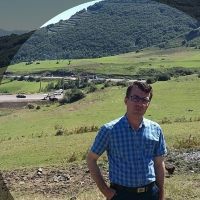Spatio-Temporal Assessment of River Flow Discharge Variability Indices in Some Watersheds of Ardabil Province
Author(s):
Article Type:
Research/Original Article (دارای رتبه معتبر)
Abstract:
Introduction
The analysis of the temporal and spatial variations of surface runoff is one of the important issues in hydrology, water and soil resources management, and environmental science. Variability is an intrinsic component of environmental factors and elements. Today, the study of changes in hydrological patterns and processes is one of the most important requirements for water and soil resources management. The temporal and spatial variations of runoff flow and discharge in terms of water use and exploitation have many economic effects, and this variability is the main cause of floods and droughts at different scales. In addition, hydrological processes, by changing the spatial and temporal scales, provide different responses that limit the repeatability of hydrological observations. In general, the tools of assessing changes in hydro-climatic time series include information theory and dominance measure. The first category indices include the Shannon Index and the Brillouin Index. While, the dominance measures include the Simpson index, the McIntosh index, and the Berger-Parger index, the indices of information theory measures have the best parameters. The Shannon index has a better distribution than Simpson or Berger Parker. While the Braillein index has a similar distribution to the Shannon index, it limits ranges from zero to one.Therefore, the main purpose of this research was to evaluate the spatial and temporal changes of the Discharge Variability Indices (DVI) of surface runoff in some watersheds of Ardabil Province.
Methodology
Toward this attempt, the discharge variability indices of river flow fluctuations were calculated on a monthly time-scale including Shannon, Brillouin, Simpson, McIntosh, Berger-Parker, Index of Variability, Rainfall Anomaly Index, and Discharge Variability Index. For this puprpose, 22 river gauge stations in Ardabil Province were selected. First, the index values were calculated in the Excel software. After calculating these indices, their spatial variations were investigated in the studied area using the distance mapping method in ArcGIS 10.1. The spatial variations of the indices in the studied area were evaluated. In addition, the Triple Diagram Models were used to determine the temporal variation of the DVIs in relation to flow changes over the study time periods using Surfer software. Next, the Pearson correlation coefficient between the discharge variability indices were performed using R software.
Results and Discussion
The results showed that the variability of the DVIs were higher in the upstream regions than the downstream regions, which can be related to the less changes in river flow regimes and the limited interference caused by human utilizations. The highest and lowest values of the coefficient of variation were observed in the Macintosh and DAI+ indices respectively with the values of 195.55% and -567.06%. The results of the triple diagram models indicated that the variability of DVIs were higher in low river flow values. According to the interpolation results, the upstream stations were less variable, while in the downstream stations, the degree of variability was greater due to different human interactions. Based on the results of the triple diagram models, it can be said that the variability of Shannon, Simpson, Berger-Parker, McIntosh, and DVI indices was lower in low discharge values. Also, the DAI+ and DAI- indices were more variable in lower discharge values. The results also showed that there was a significant correlation between the Brillouin index and Index of Variability (-0.42), while the Berger index -Parker and Index of Variability had a positive correlation (0.91). Also, there was a significant positive correlation between RAI+ and RAI- indices (0.62) and the correlation between RAI- and DVI was significant (0.64). In addition, the degree of variability had decreased in recent years. Also, the correlation relationship of DVIs were tested using the R software.
Conclusion
Based on the results, in the upstream regions, the flow rate of the rivers was much lower than the downstream river gauge stations, which can be explained by the condition of the flow near the natural flow of the river. However, in the downstream stations on the main river (such as Samian and Arbab Kandi stations), the existence of Yamchi and Sabalan dams have been caused by a disruption and through the regulatory effect of the dam. In general, the Shannon index as an information-based index and Simpson (dominance-based index) yielded different results from other indicators. Most of the indices showed that the rate of variability in the low flow was higher than the high discharge values. In addition, in recent periods, the degree of variability of the flow has decreased based on most indices, although determining the cause of reducing the variability caused by climate change or human activities requires further studies. The assessment of the variability of the flow at the watershed scale allows the optimal utilization of surface water in the proper seasons and determines the effect of human activities on the river regime.Keywords:
Language:
Persian
Published:
Hydrogeomorphology, Volume:5 Issue: 17, 2019
Pages:
23 to 44
magiran.com/p1944714
دانلود و مطالعه متن این مقاله با یکی از روشهای زیر امکان پذیر است:
اشتراک شخصی
با عضویت و پرداخت آنلاین حق اشتراک یکساله به مبلغ 1,390,000ريال میتوانید 70 عنوان مطلب دانلود کنید!
اشتراک سازمانی
به کتابخانه دانشگاه یا محل کار خود پیشنهاد کنید تا اشتراک سازمانی این پایگاه را برای دسترسی نامحدود همه کاربران به متن مطالب تهیه نمایند!
توجه!
- حق عضویت دریافتی صرف حمایت از نشریات عضو و نگهداری، تکمیل و توسعه مگیران میشود.
- پرداخت حق اشتراک و دانلود مقالات اجازه بازنشر آن در سایر رسانههای چاپی و دیجیتال را به کاربر نمیدهد.
In order to view content subscription is required
Personal subscription
Subscribe magiran.com for 70 € euros via PayPal and download 70 articles during a year.
Organization subscription
Please contact us to subscribe your university or library for unlimited access!



